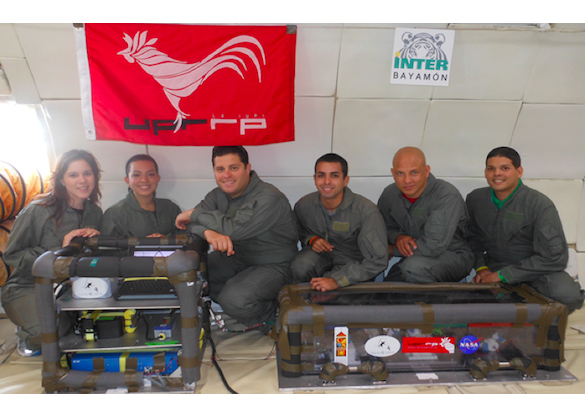Microgravity Effects of Nanoscale Mixing on Diffusion Limited Processes Using Electrochemical Electrodes
PI: Carlos Cabrera, University of Puerto Rico - Rio Pedras
PI: Carlos Cabrera, University of Puerto Rico - Rio Pedras

- TA10 Nanotechnology
This project is for a study of the microgravity effects on nanoscale mixing of a diffusion limited process using electrochemical electrodes. In previous research by Micro-G CANM 1, the electrochemical oxidation of ammonia in microgravity conditions was utilized as the means to characterize a variety of nanomaterials according to their catalytic activity. The results of these parabolic aircraft experiments led to the measurement of a 20-65% decrease in the catalytic current under microgravity. This reduction in catalytic current is hypothesized to occur due to the lack of buoyancy driven mixing at the solution-electrode interface. It is believed that this effect is influenced by the pore size and structure of the material. This lack of buoyancy driven mixing at the solution-electrode interface may be addressed by inducing hydrodynamic turbulent mixing and by the reengineering of the electrode geometry and pore structure.
The objective of this project is to test these mitigation approaches and develop a better understanding of this phenomenon. The proposed research meets the requirements for the classification of a TRL 5 (Component and or breadboard validation in a relevant environment).
This project is critical to the Forward Osmosis Secondary Treatment (FOST) system being developed by NASA Ames Research Center and failure to complete this microgravity evaluation will result in a failure to meet key Next Generation Life Support program’s milestones. The design of the electrodes in the EAR is critical to its correct sizing and thus the FOST system.
This project will evaluate the effect on electrode performance by: employing hydrodynamic turbulence at different flow rates towards a platinum catalyst electrodeposited on a glassy carbon electrode, changing the electrode structure by utilizing bulk electrolysis, and changing the pore size by the utilization of three different mesoporous carbon supports (average diameters of: 64, 100 and 137 Å).
The Electrochemical Microgravity Laboratory (EML) is comprised of two major components: (1) Electronics Rack (ELR) to control the electrochemical operation and (2) Experimental Equipment Box (EEB) double contained Makrolon™ box safely containing the electrochemical cells (triple containment in overall).
Technology Details
-
Selection DateAFO3 (Mar 2012)
-
Program StatusCompleted
- 2 Parabolic
Development Team
-
PICarlos Cabrera
-
Organization
-
SponsorNASA URC – Center for Advanced Nanoscale Materials (CANM)
NASA Ames Research Center -
More Information

